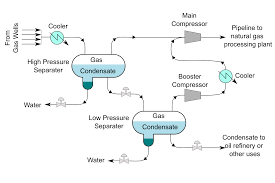Definition: Gas-liquid absorption is a mass transfer operation where a soluble gas is transferred from a gas phase to a liquid phase.
Click the Translate button(see right) on this post to set your Own Language to understand more perfectly!!
Gas-Liquid Absorption Calculator
Definition Continue: Gas-Liquid Absorption
Gas-liquid absorption is a mass transfer operation where a soluble gas is transferred from a gas phase to a liquid phase. Key parameters influencing this process include:
Key Factors:
Gas Flow Rate (m³/hr): The volume of gas passing through the absorber per hour.
Liquid Flow Rate (m³/hr): The volume of liquid used to absorb the gas per hour.
Gas Concentration (%): The concentration of the target gas in the inlet gas stream.
Liquid Concentration (%): The concentration of the absorbed gas in the liquid phase at the outlet.
Sample Values:
Gas Flow Rate: 1000 m³/hr
Liquid Flow Rate: 500 m³/hr
Gas Concentration: 5% (v/v)
Liquid Concentration: 2% (w/w)
Calculation Example:
Calculating Gas and Liquid Mass Flow Rates:
Assuming air as the carrier gas with a density of 1.2 kg/m³:
Gas mass flow rate = Gas flow rate * Gas density = 1000 m³/hr * 1.2 kg/m³ = 1200 kg/hr
Assuming water as the absorbing liquid with a density of 1000 kg/m³:
Liquid mass flow rate = Liquid flow rate * Liquid density = 500 m³/hr * 1000 kg/m³ = 500000 kg/hr
Calculating Mass Transfer Rate:
This requires additional information about the system, such as equilibrium relationships, mass transfer coefficients, and column dimensions.
Additional Considerations:
Equilibrium Relationship: Describes the distribution of the gas between the gas and liquid phases at equilibrium.
Mass Transfer Coefficients: Quantify the rate of mass transfer across the gas-liquid interface.
Column Design: The type of absorber (packed bed, plate column) and its dimensions affect mass transfer efficiency.
Operating Conditions: Temperature, pressure, and liquid properties influence the absorption process.
Example Calculation (Simplified):
Assuming a simple system with a linear equilibrium relationship and constant mass transfer coefficients, we can estimate the outlet gas concentration.
Overall mass transfer coefficient: K = 0.1 (made-up value for illustration)
Contact time: 2 minutes
Mass transfer rate: N = K * A * (Cgi - Cgi*)
Where N is the mass transfer rate, A is the contact area, Cgi is the inlet gas concentration, and Cgi* is the gas concentration at the interface.
Outlet gas concentration: Cge = Cgi - (N / (G * Cp))
Where Cge is the outlet gas concentration, G is the gas mass flow rate, and Cp is the gas specific heat capacity.
Note: This is a highly simplified example. Actual calculations involve complex mass transfer models and experimental data.
Gas-liquid absorption is a complex process influenced by various factors. A thorough understanding of these factors is essential for designing efficient absorption systems.
Let's Delve Deeper into Gas-Liquid Absorption
Specific Applications of Gas-Liquid Absorption
Gas-liquid absorption finds applications in various industries. Let's explore a few:
Industrial Processes:
Removal of acid gases (CO2, H2S) from industrial flue gases.
Recovery of valuable components (e.g., ammonia, organic solvents) from process streams.
Air pollution control (scrubbing of NOx, SOx).
Environmental Protection:
Removal of volatile organic compounds (VOCs) from industrial emissions.
Treatment of wastewater containing dissolved gases.
Chemical Industry:
Production of various chemicals through absorption processes (e.g., sulfuric acid, nitric acid).
Deeper Dive into Calculation Methods
Gas-liquid absorption calculations can be complex, involving mass transfer principles, equilibrium relationships, and column design. Let's explore some key aspects:
Mass Transfer Coefficients: These quantify the rate of mass transfer across the gas-liquid interface. Correlations and experimental data are often used to estimate these coefficients.
Equilibrium Relationships: Describe the distribution of the gas between the gas and liquid phases at equilibrium. Henry's law is commonly used for dilute solutions.
Column Design: Factors like column height, diameter, packing type, and liquid distribution affect the overall performance of the absorber. Numerical Methods: For complex systems, numerical methods (e.g., finite difference, finite element) can be employed to solve mass transfer equations.
How is it possible to Earn Money using the knowledge of Gas-Liquid Absorption Calculation in our practical life?????
Monetizing Gas-Liquid Absorption Knowledge
Understanding gas-liquid absorption is crucial in various industries. Here's how this knowledge can be monetized:
Consulting Services
Process Optimization: Help industries improve the efficiency of their gas-liquid absorption processes by analyzing performance data, identifying bottlenecks, and recommending improvements.
Equipment Design: Provide expertise in designing and sizing absorption equipment (columns, packings, etc.) to meet specific process requirements.
Troubleshooting: Assist in diagnosing and resolving issues in existing absorption systems.
Research and Development
New Absorbent Development: Research and develop novel absorbents with enhanced mass transfer properties for specific applications.
Process Improvement: Investigate and implement new technologies to improve absorption efficiency and reduce operating costs.
Sales and Marketing
Equipment Sales: Sell absorption equipment and related components to industries requiring gas-liquid separation.
Chemical Sales: Sell solvents or other chemicals used in absorption processes.
Education and Training
Workshops and Seminars: Conduct training programs on gas-liquid absorption principles and design for engineers and operators.
Online Courses: Develop online courses on the subject.
Other Avenues
Expert Witness: Provide expert testimony in legal cases involving gas-liquid absorption processes.
Technical Writing: Write articles, papers, or books on gas-liquid absorption technology.
Key to success:
Deep understanding of mass transfer principles and absorption equipment.
Strong problem-solving and analytical skills.
Ability to communicate complex technical information to a diverse audience.
Networking with industry professionals to stay updated on the latest advancements.
By effectively applying your knowledge of gas-liquid absorption, you can create value for industries and generate income through various avenues.
Do YOU Want To Earn Money In Various Ways, Click The Link & Explore Your Field of Interest!!!









